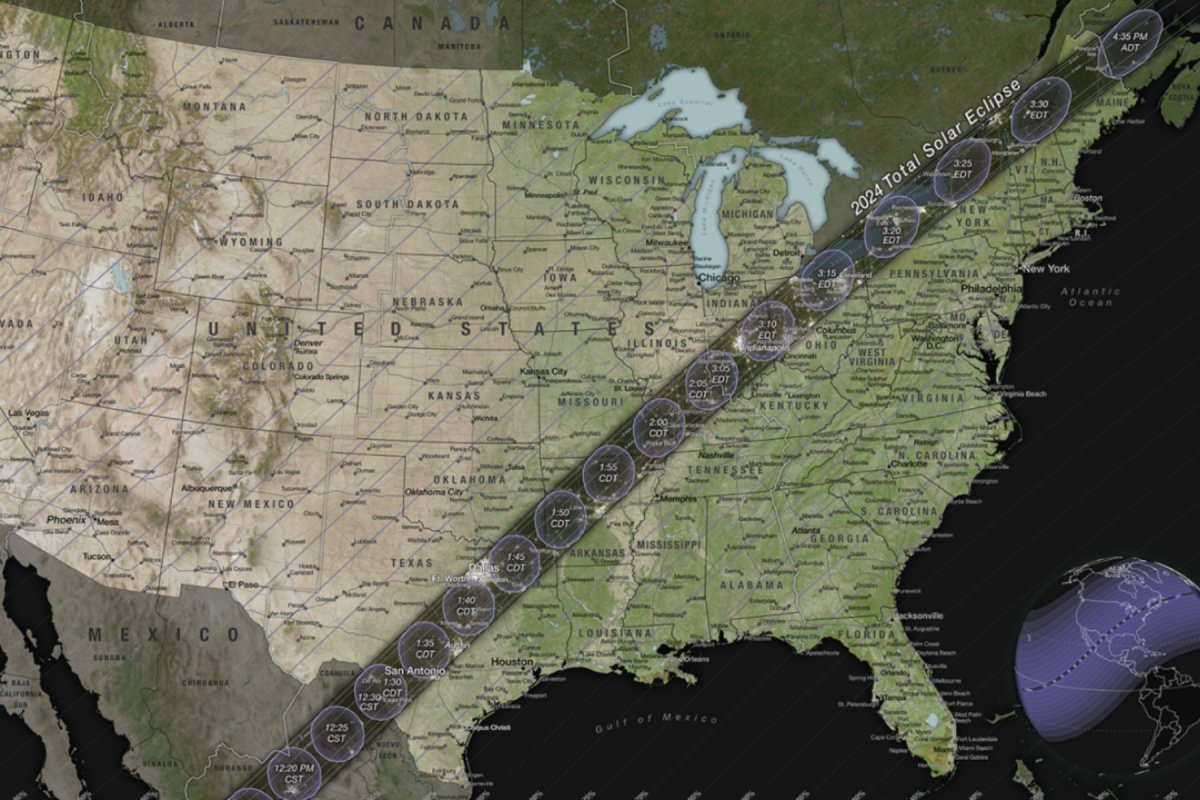The U.S. will soon get a special cosmological treat, as a total eclipse is set to creep across the country in a few weeks.
On April 8, the moon will be positioned in such a way that the entire disc of the sun will be blocked out for several U.S. states, plunging millions of people into darkness during the early afternoon.
A NASA map shows the path of the 2024 totality across the country. Around 31.6 million people across the country will be in the path of this totality, which is when the sun is totally blocked from view. Millions more will be able to view the partial eclipse. In fact, every state in the contiguous U.S. will be able to see some form of the eclipse, total or partial, with only small parts of Hawaii and Alaska missing out.
The path of this year's totality will start in Mexico and extend across Texas, Oklahoma, Arkansas, Missouri, Illinois, Indiana, Ohio, New York, Pennsylvania, Vermont, New Hampshire and Maine before heading out over the North Atlantic.

The duration of totality will vary depending on the observer's location within the path, ranging from a few seconds to around four minutes and 28 seconds at the maximum. The eclipse will be partial (but very nearly total) in three states near the path of the totality: Tennessee, Kentucky and Michigan.
A total solar eclipse is a natural phenomenon that occurs when the moon passes directly between the Earth and the sun, completely blocking out the sun's light for a short time from the perspective of viewers within the path of totality. This alignment causes the moon to cast its shadow on the Earth.
A partial solar eclipse occurs when the moon partially covers the sun from the perspective of an observer on Earth. The extent of the partial eclipse and the fraction of the sun that appears obscured vary, depending on the observer's location relative to the path of the eclipse.
Because the moon's position will be slightly closer this year than it was in 2017, the path of totality will be wider in 2024, stretching between 108 and 122 miles across, according to NASA.
It's crucial to protect your eyes from potential damage when watching a solar eclipse, whether it is total or partial. This can be done by using a pair of solar viewing glasses that are specifically designed for viewing the sun, as they have special solar filters that block harmful ultraviolet, visible and infrared radiation. If you're using a camera to photograph the eclipse, attach a solar filter to the lens to protect both your eyes and the camera's sensor from damage.

Total eclipses may one day stop happening altogether, as the moon is moving slowly but surely away from the Earth. It's only about 3.8 centimeters every year, but this will eventually mean that in many millions of years the moon will no longer totally cover the sun in our skies.
"The moon is moving away from Earth very slowly, and in about 563 million years it will be far enough away that total solar eclipses are no longer possible," Michael Kirk, a NASA heliophysicist based at NASA's Goddard Space Flight Center in Greenbelt, Maryland, told Newsweek. "After that point, people on Earth will only be able to see annular or partial solar eclipses."
After April's event, the next solar eclipse to occur anywhere in the world will be on August 12, 2026, with the totality being visible from Greenland, Iceland, Portugal, Spain and Russia. The next total solar eclipse where the totality will be seen from the contiguous United States will be on August 23, 2044.
Do you have a tip on a science story that Newsweek should be covering? Do you have a question about outer space? Let us know via science@newsweek.com.
Uncommon Knowledge
Newsweek is committed to challenging conventional wisdom and finding connections in the search for common ground.
Newsweek is committed to challenging conventional wisdom and finding connections in the search for common ground.
About the writer
Jess Thomson is a Newsweek Science Reporter based in London UK. Her focus is reporting on science, technology and healthcare. ... Read more





